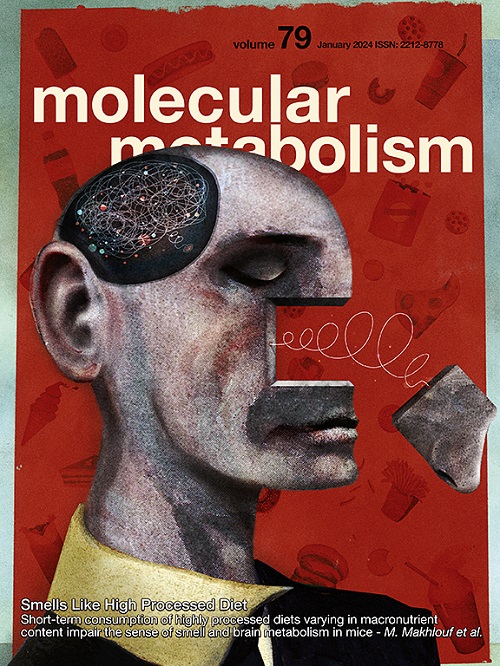肾脏中未见UCP1。
IF 7
2区 医学
Q1 ENDOCRINOLOGY & METABOLISM
引用次数: 0
摘要
目的:最近的几项研究表明,UCP1在肾脏中存在,挑战了UCP1仅存在于棕色和米色脂肪细胞的范式,拓宽了UCP1的(病理)生理意义。肾脏定位是免疫组织化学研究的直接结果,也是从多系报告小鼠中推断出来的结果。这些发现需要证实和进一步的生理表征。方法:采用免疫组织化学和qPCR检测肾脏中UCP1的表达。通过肾门或靠近肾门的横切面,包括肾周棕色脂肪和邻近肾组织,用四种UCP1抗体进行分析。结果:除了在肾周脂肪组织中检测到UCP1外,我们还用我们自己的UCP1抗体“C10”在肾脏中观察到明显的免疫阳性结构,这与早期的报道明显一致。为了证实这一点,我们在ucp1消融小鼠的肾切片上测试了c10抗体,但在这些ucp1阴性的组织中发现了相同的反应性。然后,我们测试了广泛使用的抗体ab10983,该抗体以前用于肾脏研究。同样,在ucp1消融的小鼠中,阳性信号持续存在,显然使早期的发现无效。UCP1 qPCR研究也未能检测到背景以上的UCP1 mRNA。最后,两种高特异性抗体E9Z2V和EPR20381在肾周脂肪组织中准确检测到UCP1,而在肾脏中无信号。结论:当实施适当的对照时,没有证据表明肾脏中存在UCP1。因此,这一结论也意味着,来自UCP1报告小鼠的结果,特别是关于UCP1基因在肾脏中的表达,尽管可能适用于其他组织,但在被接受为UCP1存在于非脂肪组织的证据之前,需要再次确认。本文章由计算机程序翻译,如有差异,请以英文原文为准。

No UCP1 in the kidney
Objectives
Several recent studies have indicated the presence of UCP1 in the kidney, challenging the paradigm that UCP1 is only found in brown and beige adipocytes and broadening the (patho)physiological significance of UCP1. The kidney localization has been the direct result of immunohistochemical investigations and an inferred outcome from multiple lines of reporter mice. These findings require confirmation and further physiological characterization.
Methods
We examined UCP1 expression in the kidney using immunohistochemistry and qPCR. Transversal sections through or near the kidney hilum, consistently including perirenal brown fat and adjacent kidney tissue, were analyzed with four UCP1 antibodies.
Results
In addition to detecting UCP1 in perirenal adipose tissue, we observed distinct immunopositive structures in the kidney with our in-house UCP1-antibody, ‘C10’, in apparent agreement with earlier reports. To corroborate this, we tested the C10-antibody on kidney sections from UCP1-ablated mice but found equal reactivity in these UCP1-negative tissues. We then tested the widely used antibody ab10983, previously employed in kidney studies. Also here, the positive signal persisted in UCP1-ablated mice, clearly invalidating earlier findings. UCP1 qPCR studies also failed to detect UCP1 mRNA above background. Finally, two highly specific antibodies, E9Z2V and EPR20381, accurately detected UCP1 in perirenal adipose tissue but showed no signal in the kidney.
Conclusions
When appropriate controls are implemented, there is no evidence for the presence of UCP1 in the kidney. Consequently, this conclusion also implies that the results from UCP1 reporter mice, specifically regarding kidney expression of the UCP1 gene – though possibly applicable to other tissues – require reconfirmation before being accepted as evidence for the presence of UCP1 in non-adipose tissues.
求助全文
通过发布文献求助,成功后即可免费获取论文全文。
去求助
来源期刊

Molecular Metabolism
ENDOCRINOLOGY & METABOLISM-
CiteScore
14.50
自引率
2.50%
发文量
219
审稿时长
43 days
期刊介绍:
Molecular Metabolism is a leading journal dedicated to sharing groundbreaking discoveries in the field of energy homeostasis and the underlying factors of metabolic disorders. These disorders include obesity, diabetes, cardiovascular disease, and cancer. Our journal focuses on publishing research driven by hypotheses and conducted to the highest standards, aiming to provide a mechanistic understanding of energy homeostasis-related behavior, physiology, and dysfunction.
We promote interdisciplinary science, covering a broad range of approaches from molecules to humans throughout the lifespan. Our goal is to contribute to transformative research in metabolism, which has the potential to revolutionize the field. By enabling progress in the prognosis, prevention, and ultimately the cure of metabolic disorders and their long-term complications, our journal seeks to better the future of health and well-being.
 求助内容:
求助内容: 应助结果提醒方式:
应助结果提醒方式:


